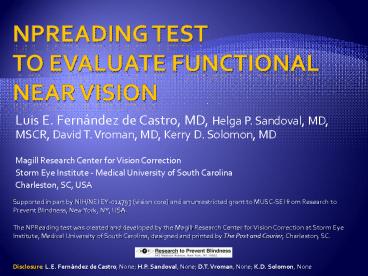NPReading Test to Evaluate Functional Near Vision PowerPoint PPT Presentation
1 / 11
Title: NPReading Test to Evaluate Functional Near Vision
1
NPReading Test to Evaluate Functional Near Vision
- Luis E. Fernández de Castro, MD, Helga P.
Sandoval, MD, MSCR, David T. Vroman, MD, Kerry D.
Solomon, MD - Magill Research Center for Vision Correction
- Storm Eye Institute - Medical University of South
Carolina - Charleston, SC, USA
Supported in part by NIH/NEI EY-014793 (vision
core) and an unrestricted grant to MUSC-SEI from
Research to Prevent Blindness, New York, NY,
USA. The NPReading test was created and
developed by the Magill Research Center for
Vision Correction at Storm Eye Institute, Medical
University of South Carolina, designed and
printed by The Post and Courier, Charleston, SC.
Disclosure L.E. Fernández de Castro, None H.P.
Sandoval, None D.T. Vroman, None K.D. Solomon,
None
2
Introduction
- Functional vision is what persons use to see when
engaged in any real-world activity such as
reading or driving - Patients who show no or minimal impairment of
visual acuity may still have loss of functional
vision - Current charts used to evaluate sight include
- Snellen chart
- ETDRS chart that use black letters on an
illuminated white background - Near vision charts
3
Introduction
- Limitations of traditional chart testing include
- Variations in testing and ending procedures
- Restrictions of numbers and sizes of optotypes
- Optotype memorization
- Do not measure functional vision
- Given the increasing relevance of near-vision
function in the clinical setting, there is a
trend to develop standardized tests of reading
performance that better replicate real-world
visual stimuli
4
Introduction
- MNread Acuity and the German Radner Reading
Charts - Evaluate reading performance in patients with
ocular conditions 1-6 - Refractive error
- Cataract
- Multifocal IOLs
- Maculopathy
- Similar to visual acuity charts, current reading
tests use black letters on a backlit high
contrast background
5
Purpose
- We propose a new method to assess functional
vision to close the gap between current methods
of quantifying visual acuity and true real-world
visual functioning - The purpose is to present a new innovative
reading performance test (NPReading test)
6
(No Transcript)
7
Patients and Methods
- A total of 82 subjects
- English first language
- Ages between 21 and 83 years
- With completed middle school or beyond
- Subjects were divided in 4 groups based on lens
status and type of IOL - The test was performed binocularly at a set
reading distance of 32 cm with a constant chart
luminance of 80 to 100 cd/m2 measured with a
lightmeter
- Patients were instructed to read out loud one
selected paragraph (100 words) for each font size
and to read without correcting any reading error - Starting from the largest font to the smallest
font - The reading time was measured with a stopwatch
and recorded - Reading speed in words per minute at different
print sizes using American point-type was
calculated
8
Results
- Demographics
9
(No Transcript)
10
Conclusion
- Subjects older than 60 years near-corrected
(monofocal control group) read in a similar
pattern than younger subjects - However, their reading speed was predictably
slower, as it has been shown that reading speed
decreases with age - Multifocal IOL subjects were able to read as well
as the monofocal control while monofocal subjects
without correction showed a reading speed slower
than the monofocal controls and multifocal
groups. - The number of subjects that were able to read
decreased as the font size decreased in all
groups - Similarly to previous publications7,8 preliminary
results show a decrease from optimum speed for
small and larger sizes - The NPReading test is an effective novel tool
that reflects and evaluates the real world
functional near vision - Ongoing study to determine validity and
reliability of the NPReading test
11
References
- 1. Richter-Mueksch S, Kaminski S, Kuchar A,
Stifter E, et al. Influence of laser in situ
keratomileusis and laser epithelial keratectomy
on patients reading performance. J Cataract
Refract Surg 2005311544-1548. - 2. Rice ML, Birch EE, Holmes JM. An abbreviated
reading speed test. Optom Vis Sci. 2005
Feb82128-133. - 3. Virgili G, Pierrottet C, Parmeggiani F, et
al.MNREAD charts. Reading performance in patients
with retinitis pigmentosa a study using the
MNREAD charts. Invest Ophthalmol Vis Sci.
2004453418-3424. - 4. Stifter E, Sacu S, Weghaupt H, et al. Reading
performance depending on the type of cataract and
its predictability on the visual outcome. J
Cataract Refract Surg. 2004301259-1267. - 5. Richter-Mueksch S, Weghaupt H, Skorpik C, et
al. Reading performance with a refractive
multifocal and a diffractive bifocal intraocular
lens. J Cataract Refract Surg. 2002281957-1963. - 6. Richter-Mueksch S, Stur M, Stifter E, et al.
Differences in reading performance of patients
with Drusen maculopathy and subretinal fibrosis
after CNV. Graefes Arch Clin Exp Ophthalmol.
2005271-9. - 7. Legge GE, Pelli DG, Rubin GS, et al.
Psycophysics of reading I normal vision. Vision
Res 1985 25239-252. - 8. Legge GE, Rubin GS, Pelli DG, et al.
Psycophysics of reading II low vision. Vision
Res 1985 25253-266.

